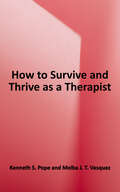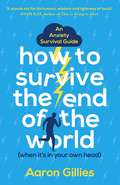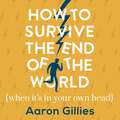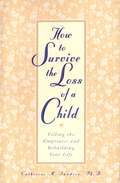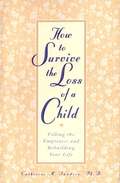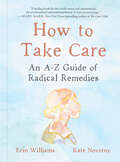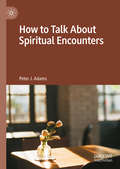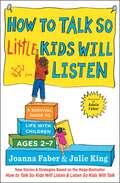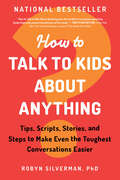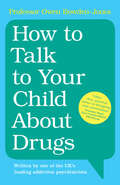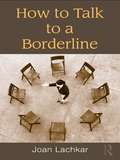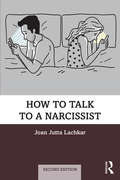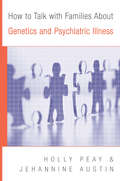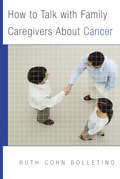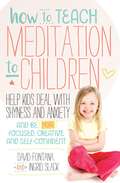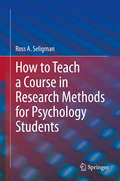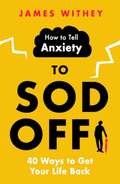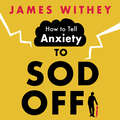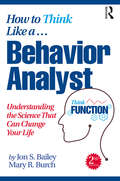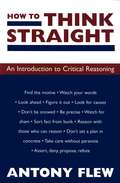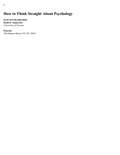- Table View
- List View
How to Survive and Thrive As a Therapist: Information, Ideas, and Resources for Psychologists in Practice
by Kenneth S. Pope Melba J.T. VasquezThis book is a nuts-and-bolts guide to starting, growing, or improving a psychotherapy practice. Graduate psychology programs offer a wealth of information on honing one's therapeutic skills, but often provide little information on the "how to's" of practice: creating a successful business plan; tailoring your practice to suit your needs, talents, and values; marketing your services; finding an office that works for you and your clients; developing forms, policies, and procedures; finding the right attorney and professional liability insurance; responding to licensing, malpractice, or ethics complaints; using computers safely, efficiently, and effectively; and; taking care of yourself so you can provide the best possible service to your clients. All of these topics are covered in this book. <p><p>Both psychologists just starting out and seasoned practitioners who want to expand, restructure, or enrich their practices will appreciate the authors' wit and wisdom. In addition to the 15 chapters, the book contains 15 appendices that make key APA professional standards and guidelines and other resources available for consultation in one handy source.
How to Survive the End of the World (When it's in Your Own Head): An Anxiety Survival Guide
by Aaron Gillies'A brilliant and funny read for the apocalyptically-minded' Matt Haig, author of Reasons to Stay Alive'In a sea of books about mental health, it stands out for its humour, wisdom and lightness of touch' Adam Kay, author of This is Going to Hurt'Just the laugh you need for when everything seems terrible' Evening StandardThere are plenty of books out there on how to survive a zombie apocalypse, all-out nuclear war, or Armageddon. But what happens when it feels like the world is ending every single time you wake up? That's what having anxiety is like - and How to Survive the End of the World is here to help. Or at least make you feel like you're not so alone.From helping readers identify the enemy, to safeguarding the vulnerable areas of their lives, Aaron Gillies examines the impact of anxiety, and gives readers some tools to fight back - whether with medication, therapy, CBT, coping techniques or simply with a dark sense of humour.And now more than ever, it's vital to take care of your mental health. How to Survive is full of funny, sweary, actually helpful tips on how to cope during self-isolation, from moving around and keeping your brain box busy to eating a green thing once in a while. These are anxious and uncertain times, but How to Survive the End of the World is here to help you give yourself a break. You deserve it. 'Fast-paced, amusing and insightful' Guardian'I LOVED it' Juno Dawson, author of The Gender Games'Hilarious and deeply insightful' Dean Burnett, author of The Idiot Brain
How to Survive the End of the World (When it's in Your Own Head): An Anxiety Survival Guide
by Aaron Gillies'A brilliant and funny read for the apocalyptically-minded' Matt Haig, author of Reasons to Stay Alive'In a sea of books about mental health, it stands out for its humour, wisdom and lightness of touch' Adam Kay, author of This is Going to Hurt'Just the laugh you need for when everything seems terrible' Evening StandardThere are plenty of books out there on how to survive a zombie apocalypse, all-out nuclear war, or Armageddon. But what happens when it feels like the world is ending every single time you wake up? That's what having anxiety is like - and How to Survive the End of the World is here to help. Or at least make you feel like you're not so alone.From helping readers identify the enemy, to safeguarding the vulnerable areas of their lives, Aaron Gillies examines the impact of anxiety, and gives readers some tools to fight back - whether with medication, therapy, CBT, coping techniques or simply with a dark sense of humour.'Fast-paced, amusing and insightful' Guardian'I LOVED it' Juno Dawson, author of The Gender Games'Hilarious and deeply insightful' Dean Burnett, author of The Idiot Brain(P)2018 Hodder & Stoughton Limited
How to Survive the Loss of a Child
by Catherine Sanders"Thank you, Catherine Sanders, for giving us a book that few others could have written. Every page speaks both the depth of your compassion and the breadth of your knowledge. This book will be a wise companion on the difficult journey from loss to recovery."-- Robert Kastenbaum, Ph.D., author of The Psychology of Death "How to Survive the Loss of a Child is a godsend to those in the field as well as to those of us in need of such a resource for our own mourning."-- Eugene Knott, Ph.D., University of Rhode Island "Dr. Sanders' insights are profound and poignant."-- Patricia Geiger, M.D., pediatrician, Boone, North Carolina "Thank you so much for all that you do for bereaved parents but especially for writing How to Survive the Loss of a Child. I know that it has changed lives. It changed mine!"-- Nancy Ulmer, bereaved parent, Kindermourn, Charlotte, North Carolina It is only through experiencing grief that bereaved parents ultimately heal. Moving through the phases of grief, the bereaved person works toward restoration. Understanding these phases, knowing what to expect, and learning what they can do to help themselves give parents greater assurance and comfort. In How to Survive the Loss of a Child, Dr. Sanders, a bereaved parent herself, offers grieving parents practical help and emotional support. This book also helps family members, friends, and caregivers relate to grieving parents and aids them, too, in understanding the process of healing through grief.From the Trade Paperback edition.
How to Survive the Loss of a Child: Filling the Emptiness and Rebuilding Your Life
by Catherine M. SandersIn How to Survive the Loss of a Child, Dr. Sanders, a bereaved parent herself, offers grieving parents practical help and emotional support. This book also helps family members, friends, and caregivers relate to grieving parents and aids them, too, in understanding the process of healing through grief.
How to Survive the Loss of a Love: 58 Things to do When There is Nothing to be Done
by Harold Bloomfield Melba Colgrove Peter McWilliams"This remarkable book deals in a warm, informative and directly helpful way with one of the most common (and certainly most painful) of human experiences--loss. Written by a psychologist, a psychiatrist and a poet, this kindly, witty and companionable book is a unique guide to overcoming grief and unhappiness--a practical manual for emotional survival. Divided into fifty-eight sections, HOW TO SURVIVE THE LOSS OF A LOVE offers a gathering of things the reader can do, things that comfort and help in a real and natural way."
How to Take Care: An A-Z Guide of Radical Remedies
by Erin Williams Kate NovotnyA simple but radical guidebook for anyone learning to care for themselves and others, with vibrant color illustrations. Healing is not just for people who have their s&*t together. Healing is, most important, for people who are falling apart. How to Take Care will help you learn to trust your instincts, listen to your body, and practice small, easy steps to soothe anxiety, burnout, and symptoms of PTSD.From A (adaptogenic herbs, ancestral healing) to Z (zoetic), How to Take Care is for anyone striving to live slowly, with self-compassion, one moment at a time. Learn tangible steps to dispel shame, tell the truth, and loosen the grip on whatever is holding you back. Sample guided meditations, cook nurturing recipes, and follow handy how-tos. Practice the grounding of a clean sink when you&’d rather burn the house down, or connect with nature by growing flowers from seed. Keep this guide on your nightstand or in your backpack for easy-reference tools, techniques, and strategies to calm your nervous system and come back to your body. It is a gift for yourself or anyone else who is going through a big, messy, or trying season of life.
How to Talk About Spiritual Encounters
by Peter J. AdamsThis book develops a new and innovative way of understanding how language is used when people describe their spiritual and mystical encounters. Early chapters provide overviews of the nature of spiritual encounters, how commonly they occur, and the role of language. The book then develops a unique way of understanding the dynamics of talking about spirituality, using original research to support this perspective. In particular, Peter J. Adams explores how this characteristically vague way of speaking can be viewed as an intentional and not an incidental aspect of such communications because certain types of vagueness have the capacity to engage the imaginative participation of receptive listeners. This expressive vagueness is achieved by embedding missing bits, or “gaps,” in the flow of what is described and these in turn provide sites for listeners to insert their own content. Later chapters focus on practical ways people (including helping professionals) can improve their skills in talking about their spiritual encounters. All content is situated in café conversations between four people each of whom is, in their own way, concerned with the challenges they face in converting the content of their encounters into words.
How to Talk so Little Kids Will Listen: A Survival Guide to Life with Children Ages 2-7 (The How To Talk Series)
by Joanna Faber Julie KingA must-have resource for anyone who lives or works with young kids, with an introduction by Adele Faber, coauthor of How to Talk So Kids Will Listen & Listen So Kids Will Talk, the international mega-bestseller The Boston Globe dubbed “The Parenting Bible.”For over thirty-five years, parents have turned to How to Talk So Kids Will Listen & Listen So Kids Will Talk for its respectful and effective solutions to the unending challenges of raising children. Now, in response to growing demand, Adele’s daughter, Joanna Faber, along with Julie King, tailor How to Talk’s powerful communication skills to children ages two to seven. Faber and King, each a parenting expert in her own right, share their wisdom accumulated over years of conducting How To Talk workshops with parents and a broad variety of professionals. With a lively combination of storytelling, cartoons, and fly-on-the-wall discussions from their workshops, they provide concrete tools and tips that will transform your relationship with the young kids in your life. What do you do with a little kid who…won’t brush her teeth…screams in his car seat…pinches the baby...refuses to eat vegetables…throws books in the library...runs rampant in the supermarket? Organized according to common challenges and conflicts, this book is an essential emergency first-aid manual of communication strategies, including a chapter that addresses the special needs of children with sensory processing and autism spectrum disorders. This user-friendly guide will empower parents and caregivers of young children to forge rewarding, joyful relationships with terrible two-year-olds, truculent three-year-olds, ferocious four-year-olds, foolhardy five-year-olds, self-centered six-year-olds, and the occasional semi-civilized seven-year-old. And, it will help little kids grow into self-reliant big kids who are cooperative and connected to their parents, teachers, siblings, and peers.
How to Talk to Kids About Anything: Tips, Scripts, Stories, and Steps to Make Even the Toughest Conversations Easier
by Robyn Silverman PhDTHE NATIONAL BESTSELLERA step-by-step guide to answering your kids' toughest questions "When people die, where do they go?""Why is her skin darker than mine?""But how does the baby get in there?"Don't panic. While we know that the first step to connecting deeply with our kids is being able to communicate, empathize, and answer their biggest queries, what do you do when that tricky-to-answer question comes out of the blue? Sometimes we just don't know what to say, so we simply change the subject or give a quick, throwaway answer—and hope it doesn't come up again. Dr. Robyn Silverman, host of the How to Talk to Kids About Anything Parenting Podcast, gets it. A child development specialist and mom, she'll stick with you every step of the way. In this book, Dr. Robyn takes you through the whole spectrum of kids' curious questions, giving you the strategies and scripts to prepare you for life's most challenging conversations. That way your kids get age-appropriate information straight from you, their trusted source, rather than from peers, the media, or the internet. You'll learn how to develop calm, well-thought-out answers to tricky questions on subjects including:DeathSexFriendshipDivorceMoneyAnd more!Drawing on the expertise of dozens of well-known experts, Dr. Robyn's decades of working with children and teens, and her personal experience as a mom, How to Talk to Kids About Anything is a vital resource for parents who value having honest, meaningful conversations with their kids. When you just can't find the right words, this book will be your guide to talking to your kids about anything as they grow from toddlers to teens… and beyond.Makes for a thoughtful gift for new parents!
How to Talk to Your Child About Drugs
by Owen Bowden-JonesBroaching the topic of drugs and drug use with your child can feel particularly daunting. With the illegal drug market constantly evolving, it can be difficult to stay up to date with the latest information. How to Talk to Your Child About Drugs is an evidence-based, practical guide from a leading addiction specialist. The book offers clear and accessible guidance for parents on how to have effective conversations with their child about this difficult topic. It provides a summary of both established and newly emerging drugs, how drugs work in the brain, how they cause harm, and why some people are more vulnerable than others to problems, including signs parents should be looking out for. This is a book that all parents will need at some stage. It will help you feel better informed about drugs, more confident in talking to your child, and better equipped to tackle any problems.
How to Talk to a Borderline
by Joan LachkarIn How to Talk to a Borderline, Joan Lachkar introduces Borderline Personality Disorder (BPD) and outlines the challenges and difficulties it presents to clinicians. She expands current understanding of BPD by outlining eight different kinds of borderline personality disorders and how each of these requires specific communication techniques and methods. Case examples are offered throughout the text and in some cases describe the kinds of partners borderlines attract. This book offers new approaches to communicating, working with, and treating borderline personality disorders while integrating more contemporary treatment methods.
How to Talk to a Narcissist
by Joan Jutta LachkarBringing to light new developments in the treatment of marital conflict, this second edition of How to Talk to a Narcissist addresses the ever-changing faces and phases of narcissism within the context of marital therapy. This is a practical guide that focuses on specific communication styles in addressing patients with severe narcissistic personality pathology, as well as those with borderline personality disorder. The book starts with an overview of the different kinds of narcissists and borderlines. Dr. Lachkar analyzes these high-conflict personality disorders from a clinical, psychodynamic, and psychoanalytic perspective and delves into the various defenses that a narcissist or borderline might use. Updated treatment approaches and techniques are included along with an examination of the historical and theoretical perspectives that ground these approaches. Also included are detailed case illustrations. This book is useful for both beginning and seasoned practitioners and is recommended for all clinicians treating individuals, couples, and groups within the scope of various narcissistic personality disorders.
How to Talk with Anyone about Anything: The Practice of Safe Conversations
by Harville Hendrix, Ph.D. Helen LaKelly HuntRelationships everywhere are in crisis due to our inability to talk about "difference" without polarizing. Since objection to difference is the core human problem, we need a skill that helps us connect beyond difference. That's just what New York Times bestselling authors Dr. Harville Hendrix and Dr. Helen LaKelly Hunt offer in their new book: How To Talk With Anyone About Anything. They call it the Safe Conversations Dialogue process, which everyone can learn and teach, that moves all relationships from danger to safety, making connecting possible.For centuries, most of us humans have talked to others in monologues, believing that the world is the way we see it, that what we say about it is the "truth" and we have assumed that everyone sees it "our" way. If they do not, we experience tension and conflict on many levels. On the other hand, few of us have ever listened to others while they are talking and tried to see the world from their point of view while retaining our own perspective. Instead of listening to understand and collaborate about our differences, we tend to replace their perspective with our own. This results in polarization, not only in our personal lives and work environments, but also in the political and religious arenas we inhabit. This has led to anxiety, frustration, anger, violence, and war. Clearly, the world needs a new way to talk that transcends difference and leads to collaboration, co-creation, and cooperation.Getting the Love You Want, teach that the practice of Safe Conversations Dialogue impacts the "physics of the Space Between." Here is what they mean:All of us live in and are a part of an energy field in which everything everywhere is connecting with everything everywhere. This energy field occupies the Space-Between us.When there is safety in the energy field that occupies the Space-Between us, we can connect.When there is anxiety in the Space Between, we defend ourselves. We cannot connect but tend to polarize.Anyone, if they decide to, can restore safety in the Space Between by using a structure conversation skill called the Safe Conversations Dialogue. In How to Talk with Anyone about Anything, Harville and Helen share the wisdom of the Safe Conversations process and the four structured and teachable skills that create safety and connection:Dialogue: Dialogue is two or more people taking turns talking and listening. Monologue is one person talking and expecting everyone else to listen. When two or more people shift from Monologue to Dialogue, they can transform any relationship from conflict to safety, connection and collaboration.Zero Negativity: Negativity disrupts safety and is non-negotiable for safe and thriving relationships. When Dialogue is practiced with Zero Negativity, criticism about what one does not have is replaced with a positive request for what one wants. This transforms conflict into safety and connecting.Empathy: Empathy is the capacity to experience or imagine how another person has gone through life. When Dialogue is practiced with empathy, one can more easily accept the different perspective of another person and maintain one's own perspective without polarizing.Affirmation: Affirmation is valuing another person because they exist rather than for what they have done for you. When Dialogue includes affirmation, the other person experiences themselves as human rather than as an "object" that is valued because of what they do. How to Talk with Anyone about Anything offers the keys to unlocking your ability to connect with others in a new and profoundly different way. And, as more of us hone that ability, together, we can bring about a fundamental shift in society away from our current focus on the "self" and polarization about difference towards safety and true connecti
How to Talk with Families About Genetics and Psychiatric Illness
by Holly Landrum Peay Jehannine Claire AustinAddressing clients' questions and concerns about the role of genetics in mental illness. As we learn more about how our biology and genes can play into the development of a mental health disorder, patients and their families are increasingly seeking answers to tough questions about common risk factors, the likelihood of recurrence, the need for genetic testing, and implications for future generations. A practical, go-to resource for all mental health clinicians, this guide explains just how to address these questions and concerns in a way that's comprehensible and compassionate. Filled with case studies, sample dialogues, and question-and-answer examples, it is an essential roadmap for practitioners, helping them to demystify a complex issue for their clients and equip them with the accurate, reassuring information they need.
How to Talk with Family Caregivers About Cancer
by Ruth BolletinoCancer affects not only the patient, but all their loved ones as well. This book will guide professionals on issues critical to effectively and compassionately counseling caregivers and other family members, from dealing with their feelings of grief and despair and realistically fostering hope, to helping them provide emotional and practical support to the patient during the illness and treatment.
How to Teach Meditation to Children: A Practical Guide to Techniques and Tips for Children Aged 5-18
by David Fontana Ingrid Slack Amber HatchThis is a new edition of the classic guide to teaching meditation to children – one of the first and still one of the best in terms of clarity, practicality and usability. Avoiding religious terminology, it's aimed at both parents and teachers and explains the varying techniques for working with children in different age groups (from 5 upward), offering a wide range of easy-to-follow and effective exercises. The book explains the benefits of meditation for children, from relieving shyness, anxiety and tension to reducing hyperactivity, aggression and impatience. Meditation has also proved helpful when treating asthma, insomnia and depression, and in improving concentration, establishing emotional balance and enhancing imagination and creativity. In fact, meditation is one of the best tools we can offer children to help them cope with the intensity of their feelings and ease the pressures in their lives – among family, with friends and at school. It gives even very young children power over their thinking and emotions through enhanced self-understanding and is incredibly valuable in helping adolescents to navigate the emotional peaks and valleys of the transition from childhood to adulthood. The edition will be given a new foreword by a prominent child psychologist, and a design that highlights the exercises and makes the text even easier to navigate.
How to Teach a Course in Research Methods for Psychology Students
by Ross A. SeligmanThis book is a step-by-step guide for instructors on how to teach a psychology research methods course at the undergraduate or graduate level. It provides various approaches for teaching the course including lecture topics, difficult concepts for students, sample labs, test questions, syllabus guides and policies, as well as a detailed description of the requirements for the final experimental paper. This book is also supplemented with anecdotes from the author’s years of experience teaching research methods classes. Chapters in this book include information on how to deliver more effective lectures, issues you may encounter with students, examples of weekly labs, tips for teaching research methods online, and much more. This book is targeted towards the undergraduate or graduate professor who has either not yet taught research methods or who wants to improve his or her course. Using step by step directions, any teacher will be able to follow the guidelines found in this book that will help them succeed.How to Teach a Course in Research Methods for Psychology Students is a valuable resource for anyone teaching a quantitative research methods course at the college or university level.
How to Tell Anxiety to Sod Off: 40 Ways to Get Your Life Back
by James WitheyAn accessible, comforting and practical book for anyone experiencing anxiety, from the author of The Recovery Letters and How to Tell Depression to Piss Off.Despite more and more people opening up about their mental health, anxiety is still taboo. We're not supposed to be anxious; we're supposed to be resilient and able to 'get on with it'. We are expected to excel while juggling a hectic, pressurised schedule at home and at work, despite the lines between the two being more blurred than ever.This book dispels that taboo. It is for anyone who has experienced general anxiety disorder, trauma-related anxiety, clinical anxiety and those with 'low-level' anxieties.At once empathetic and entertaining, How to Tell Anxiety to Sod Off offers 40 ways to get to a better place with anxiety. They are born out of the author's personal experience of managing his own anxiety and his many years of working as a counselor helping people with their mental health.
How to Tell Anxiety to Sod Off: 40 Ways to Get Your Life Back
by James WitheyAn accessible, comforting and practical book for anyone experiencing anxiety, from the author of The Recovery Letters and How to Tell Depression to Piss Off.Despite more and more people opening up about their mental health, anxiety is still taboo. We're not supposed to be anxious; we're supposed to be resilient and able to 'get on with it'. We are expected to excel while juggling a hectic, pressurised schedule at home and at work, despite the lines between the two being more blurred than ever.This book dispels that taboo. It is for anyone who has experienced general anxiety disorder, trauma-related anxiety, clinical anxiety and those with 'low-level' anxieties.At once empathetic and entertaining, How to Tell Anxiety to Sod Off offers 40 ways to get to a better place with anxiety. They are born out of the author's personal experience of managing his own anxiety and his many years of working as a counselor helping people with their mental health.
How to Tell Anxiety to Sod Off: 40 Ways to Get Your Life Back
by James WitheyAn accessible, comforting and practical book for anyone experiencing anxiety, from the author of The Recovery Letters and How to Tell Depression to Piss Off.Despite more and more people opening up about their mental health, anxiety is still taboo. We're not supposed to be anxious; we're supposed to be resilient and able to 'get on with it'. We are expected to excel while juggling a hectic, pressurised schedule at home and at work, despite the lines between the two being more blurred than ever.This book dispels that taboo. It is for anyone who has experienced general anxiety disorder, trauma-related anxiety, clinical anxiety and those with 'low-level' anxieties.At once empathetic and entertaining, How to Tell Anxiety to Sod Off offers 40 ways to get to a better place with anxiety. They are born out of the author's personal experience of managing his own anxiety and his many years of working as a counselor helping people with their mental health.
How to Think Like a Behavior Analyst: Understanding the Science That Can Change Your Life
by Jon Bailey Mary BurchHow to Think Like a Behavior Analyst is a revolutionary resource for understanding complex human behavior and making potentially significant quality of life improvements. Behavior analysts offer a worldview of the human condition different than almost any other professional perspective. To a behavior analyst, human behavior is largely learned and subject to change if the right variables are put into play. This is an empowering outlook, providing an opportunity for individuals to analyze the actions of those around them and an understanding of why others exhibit such behavior. Practical, clear, and direct, this book addresses basic questions such as how behavior analysis is different from psychotherapy, what analysis involves, and the meaning of evidence-based treatment. A chapter on Applications presents tips on using behavioral procedures to improve lives and deal with others, and articulates how behavioral procedures are used in community settings. In question and answer format, the text thoroughly covers 50 frequently asked questions about behavior analysis in an educational and entertaining manner. It was developed out of questions raised by students in behavior analysis classes over the last 35 years, as well as questions raised by consumers of behavior analysis services. This text is written for all professionals concerned with behavior, including undergraduate students in psychology and behavior analysis, parents, teachers, employers, and employees. The book can easily be used as a supplement to primary texts in introductory psychology courses, and the exercises that follow each question can be used to stimulate lively discussion in role-play and other active learning situations.
How to Think Like a Behavior Analyst: Understanding the Science That Can Change Your Life
by Jon S. Bailey Mary R. BurchHow to Think Like a Behavior Analyst is a revolutionary resource for understanding complex human behavior and making potentially significant quality-of-life improvements. Practical and clearly written, this second edition addresses basic questions like how behavior analysts work, why specific methods and procedures are used, what alternative "fad" treatments are, and more. The updated text answers 70 frequently asked questions about behavior analysis using an accessible question-and-answer format. Each question now includes a Quick Take, which is a simple and easy-to-read answer to the question, and then a more in-depth Technically Speaking answer that is more challenging. A brand-new chapter discusses ways of advancing one’s career in the field and how to go to graduate school and become board certified. This text is written for all professionals concerned with behavior, including undergraduate students in psychology and behavior analysis, parents, teachers, employers, and employees. The book can easily be used as a supplement to primary texts in introductory psychology courses, and the exercises that follow each question can be used to stimulate lively discussion in role-play and other active learning situations.
How to Think Straight
by Antony FlewPractical reasoning and clear thinking are essential for everyone if we are to make sense of the information we receive each day. Being able to quickly know the difference between valid and invalid arguments, the contradictory versus the contrary, vagueness and ambiguity, contradiction and self-contradiction, the truthful and the fallacious, separates clear thinkers from the crowd.How to Think Straight lays the foundation for critical reasoning by showing many ways in which our thinking goes awry. Celebrated philosopher Antony Flew entertainingly instructs on the many and varied faults that occur in argument, the power of reason, how to challenge assertions and find evidence, and how not to be persuaded by half-truths. Flew also examines poor reasoning, and why we should be concerned with finding the truth.Lucid, terse, and sensible, with study questions and exercises to help along the way, this enlightening second edition will help you develop the skills necessary to argue and reason effectively by following a few simple, easy-to-remember directions.
How to Think Straight About Psychology
by Keith StanovichWidely used and highly acclaimed, How to Think Straight About Psychology introduces students to the critical thinking skills they need to independently evaluate psychological information. Students will learn to analyze psychological claims found in the media, distinguish between pseudoscience and true psychological research, and apply psychological knowledge to the world around them. <p><p>The 11th edition covers an extensive range of new topics and examples illustrating psychological principles, pseudoscience, and issues obscuring the real and growing knowledge base in the field of psychology.
